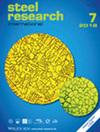高活性和低活性焦炭在富氢高炉中的应用
IF 1.9
3区 材料科学
Q2 METALLURGY & METALLURGICAL ENGINEERING
引用次数: 0
摘要
研究了在高温减载条件下,两种不同反应活性的焦炭对块状矿石冶金特性和焦炭溶解损失的影响。这项工作使用了一种改进的试验装置,用于测试铁矿石在 CO2 和 CO2H2O 两种气氛下的软化-熔化和熔滴特性。阐述了高活性焦炭在富氢条件下的劣化行为。富氢条件下的高活性焦炭更有利于提高炉料的透气性和焦炭层的渗透性。但是,它增加了软化区的厚度。高活性焦炭具有明显的内外反应梯度。溶液流失反应主要发生在表面,具有选择性。反应后,碳结构的纵向堆积高度、层数和有序度降低。外壳和内核之间的碳结构差异减弱。然而,焦炭反应活性的增强导致其表面焦炭粉末的大量流失。液滴中更容易出现未还原的 FeO 和难熔的 Fe2SiO4,不利于铁的还原和炉内渣壳的生成。块矿和焦炭分离的难度加大,炉内残留的含铁炉料增多。本文章由计算机程序翻译,如有差异,请以英文原文为准。
Application of High‐ and Low‐Reactivity Cokes in Hydrogen‐Rich Blast Furnaces
The effects of two cokes with different reactivity on the lump ore's metallurgical properties and coke's solution loss are investigated under the high‐temperature load reduction. The work used an improved test device for softening‐melting and dropping characteristics of iron ores in both CO2 and CO2 H2 O atmospheres. The deterioration behavior of highly reactive cokes is expounded under hydrogen‐rich conditions. High‐reactivity cokes under hydrogen‐rich conditions are more favorable for enhancing the breathability of charge and the penetration of the coke layer. However, it increased the thickness of the softening zone. High‐reactivity cokes had obvious internal and external reaction gradients. The solution loss reaction mostly occurred on the surface, with selectivity. The longitudinal stacking height, layer number, and order degree in the carbon structure decreases after the reaction. The carbon‐structure difference weakens between the shell and core. The enhancement of coke's reactivity, however, results in the significant loss of coke powders on its surface. Unreduced FeO and refractory Fe2 SiO4 are more likely to appear in the droplets, which is not conducive to the reduction of Fe and the generation of slag crust in the furnace. The difficulty in separating lump ores and cokes is aggravated, and more iron‐containing charge remain in the furnace.
求助全文
通过发布文献求助,成功后即可免费获取论文全文。
去求助
来源期刊

steel research international
工程技术-冶金工程
CiteScore
3.30
自引率
18.20%
发文量
319
审稿时长
1.9 months
期刊介绍:
steel research international is a journal providing a forum for the publication of high-quality manuscripts in areas ranging from process metallurgy and metal forming to materials engineering as well as process control and testing. The emphasis is on steel and on materials involved in steelmaking and the processing of steel, such as refractories and slags.
steel research international welcomes manuscripts describing basic scientific research as well as industrial research. The journal received a further increased, record-high Impact Factor of 1.522 (2018 Journal Impact Factor, Journal Citation Reports (Clarivate Analytics, 2019)).
The journal was formerly well known as "Archiv für das Eisenhüttenwesen" and "steel research"; with effect from January 1, 2006, the former "Scandinavian Journal of Metallurgy" merged with Steel Research International.
Hot Topics:
-Steels for Automotive Applications
-High-strength Steels
-Sustainable steelmaking
-Interstitially Alloyed Steels
-Electromagnetic Processing of Metals
-High Speed Forming
 求助内容:
求助内容: 应助结果提醒方式:
应助结果提醒方式:


